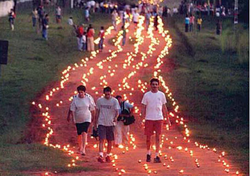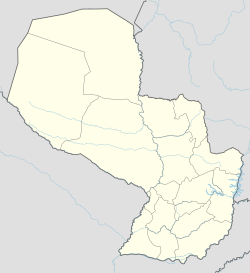San Ignacio (Paraguay)
| San Ignacio | |||
|---|---|---|---|

Good Friday procession in Tañarandy
|
|||
|
|||
 Location of the district of San Ignacio on the Misiones Department. |
|||
| Location of the district of San Ignacio on the Misiones Department. | |||
| Coordinates: 26°53′12″S 57°01′42″W / 26.88667°S 57.02833°WCoordinates: 26°53′12″S 57°01′42″W / 26.88667°S 57.02833°W | |||
| Country |
|
||
| Department |
|
||
| Founded | December 29, 1609; Fathers Marcial de Lorenzana and Francisco de San Martín, helped by the Chief Arapysandú | ||
| Government | |||
| • Mayor | Mirena Salas de Ruíz (ANR) | ||
| Area | |||
| • Total | 2,020 km2 (780 sq mi) | ||
| Elevation | 124 m (407 ft) | ||
| Population (2008) | |||
| • Total | 24,468 | ||
| • Density | 12/km2 (30/sq mi) | ||
| Time zone | -4 Gmt | ||
| Postal code | 4750 | ||
| Area code(s) | (595) (782) | ||
| Website | www.sanignacioguazu.gov.py | ||
San Ignacio (Spanish pronunciation: [san iɣˈnasjo]), also known as San Ignacio Guazú, is a city and district in the Misiones Department of Paraguay, located 225 kilometres (140 mi) from Asunción.
It was founded on December 29, 1609 by the Jesuit Priests Marcial de Lorenzana and Francisco de San Martín, accompany by Cacique (native word for “chief”) Arapysandú, who took them to his lands, where they built an altar and celebrated the first mass.
The Jesuit Mission was established officially in 1610 with the name of “San Ignacio Guazú” so it wouldn’t be confused with another mission “San Ignacio Miní” in Misiones, Argentina. In February of the same year, Father Roque González de Santa Cruz organized the mission, turning it into the center of all the Jesuit missions in Paraguay. The Jesuits that founded other towns such as: Santa Rosa, Santiago, Santa María, San Cosme y Damián and even Encarnación, left from San Ignacio in order to do so.
Originally located in the area where nowadays is Santa Rita, moved to Santiago and later to the current location.
The first inhabitants of San Ignacio were the natives that learned many arts from the European masters.
San Ignacio is an important center for commerce, cattle and agriculture, besides from the historical and cultural richness. His strategic location, in the central area of the department and with several road sections, its population is the one with the most dynamic and economical activity of the department.
It is considered “Capital of the Hispanic-Guaraní Baroque”, because of the countless pieces of art from that time that is preserve in the city. Some of them are pieces of the church of San Ignacio.
...
Wikipedia



